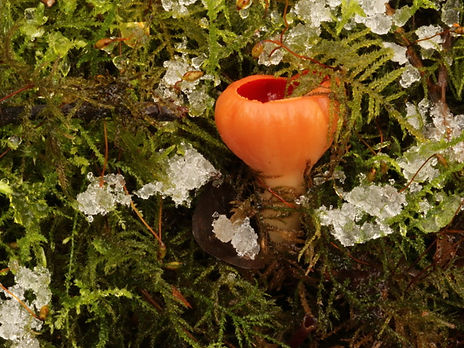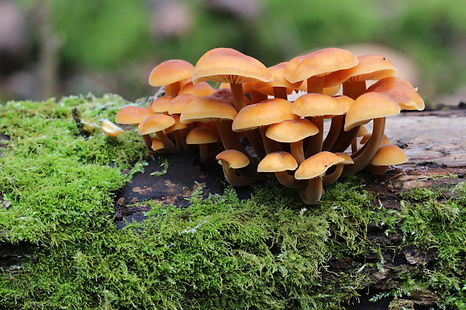
Fungus of the month
Scarlet Elf Cups in Fineshade Wood
Distinctive fungi to look for each month
by John Haughton
John is a volunteer with the Corby Woodland Project and Wildlife Trust BCN. He volunteers in the three areas of ancient woodland in Corby, but spends most of his time in King’s Wood close to where he lives. He has led several guided walks for Rockingham Forest Vision, sharing his enthusiasm for fungi. On these pages, as the months went by, he described some of the most significant fungi that you may find in the wooded areas of Rockingham Forest.
January – Scarlet Elfcup
The Scarlet Elfcup displays bright red cups with short stems and can be surprisingly difficult to see, despite often appearing in large groups. They can be found in late winter and early spring on rotting mossy pieces of hardwood, often Hazel, Elm and Willow. It is reasonably widespread, but not very common and is mostly found in damp, shady areas. They start off as very small cups hidden in the moss - one tiny one can just be seen in the bottom left of this first picture.
The Scarlet Elfcup has rounded, regular-shaped fruiting bodies that look like cups; they have a bright scarlet and smooth inner surface. The outer surface is pale pink and covered in tiny hairs. The cup has a very short stem.
There are two species of Elfcup, the Scarlet Elfcup (Sarcoscypha austriaca) and the Ruby Elfcup (Sarcoscypha coccinea). These are so similar in appearance it needs microscopic inspection of their spores to distinguish between them.
The first-nature fungus identification website suggests there are both a yellowy-orange and a white form of this fungus. Both these forms are rare, especially the white, and are worth looking for when you find group of Scarlet Elfcups. I have not seen either yet, although there are usually plenty of Elfcups in King’s Wood at this time of year.
The name of this fungus comes from a belief that the elves of the wood visit these cups in the morning and drink the dew from them. Yet another source suggests the names Moss Cups and Fairies’ Baths.


A typical group of Scarlet Elfcups

This shows the stem and looks a bit like a drinking goblet.
Also, as you can see, they survive in snow
The red inner surface is where the spores are released from, it is an ascomycota fungus, which means it actively shoots its spores into the air.
I came across the following recently and thought I might try it.
Scarlet elf cups offer one of the best opportunities to observe a spore explosion: by blowing on them (ideally in March or April) you can trigger them to shoot clouds of spores which can be seen with the naked eye.
This is not the movement of your breath raising a cloud, but the slight change in temperature that it brings triggering many thousands of spores into being expelled from the inner surface of the cup
The final picture is of the first Scarlet Elfcups emerging that I have seen in King’s Wood this year, taken on 4th January. The ‘cups’ are about 5 mm across and likely to grow a lot bigger. I shall keep visiting them and perhaps it is with these that I shall try to observe a ‘spore explosion’
February – Tripe Fungus - Auricularia mesenterica


I saw examples of this fungus on some elm logs recently on an abandoned section of the old Corby to Kettering Road near the Spread-Eagle Pub in Great Oakley.
At first glance I thought they were Turkeytails but on closer inspection it was clear that they had a very hairy upper surface with whitish-grey and tawny-brown zones and a paler margin.


Hairy upper surface
The under surface and its flexible jelly-like texture confirmed that this was Tripe Fungus which apparently, especially likes dead elm. However, I’ve previously found it on dead ash.
Tripe Fungus is gelatinous, rubbery and soft, the Latin name places it in the genus Auricularia and it is related to the Jelly Ear - Auricularia auricula-judae.
Tripe Fungus - the under surface

In this picture of Jelly Ear the under surface is showing on the top fungus with upper surface in the lower one.
Comparing the underside of these two fungi, the soft, smooth surface from which the spores are released, you’ll see some similarities, although the flesh of the Tripe Fungus is a lot thicker and generally more heavily veined than that of the Jelly Ear, and also a clear light grey tending to brown in colour rather than the Jelly Ear’s darker chestnut
Jelly Ear - Auricularia auricula-judae
March – Velvet Shank - Flammulina velutipes
This is a colourful winter- fruiting fungus that can survive being frozen without being damaged. I have found this most frequently on dead horse chestnut trees. There are two or three small trees to the rear of the ponds at East Carlton Country Park that have had a fine display of these for the past four or five years.


As my pictures show they often grow in dense, tiered clusters. The bright orange caps are especially noticeable on dark winter days and it can be found rotting down the stumps, trunks and fallen branches of dead hardwoods such as Elm, Ash, Beech, Horse Chestnut, Feld Maple and Oak.
The common English name provides an indication of its identity, namely the velvety stem. The stem is generally between 3-5cm in length and is yellow at the top where it meets the cap. gradually getting a darker brown towards the base. It has no ring.
The cap is distinctively smooth and sticky in wet weather, up to about 10cm in diameter and yellowish to orange-brown in colour, while the gills are pale yellow. The spores are white.
More recently it has been recognised that there are two or three very similar looking fungi in the Flammulina genus and it is very easy to confuse them. The British Mycological Society suggests that unless a fungus is identified by microscopic analysis it should be referred to as Flammulina species.
